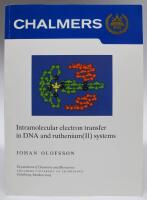
Intramolecular electron transfer in DNA and ruthenium(II) systems
Häftad bok. Chalmers University of Technology, Department of Chemistry and Bioscience. 2004.
Nära nyskick.
ENGELSK TEXT. Format 24,5 x 17,5 cm Vikt 455 g.
Häftad bok med mjuka pärmar, sv/v illustrerad med figurer, formler och tabeller. Doktorsavhandling vid Chalmers tekniska högskola, ny serie nr 2138.
Sammanfattning: When ruthenium(II) complexes with heteroaromatic ligands absorb light, an electron is pushed from the metal ion out into one of the ligands, a process called metal-to-ligand-charge-transfer (MLCT). The resulting excited state can be used to initiate further electron transfer processes, or it can decay relatively slow back into the ground state with the emission of light. In the first paper we used the ruthenium complex [Ru(phen)2dppz]2+ to study the distance dependence for electron transfer in DNA, and concluded from luminescence measurements of the system that no efficient long range electron transfer was present over distances corresponding to more than a few base pairs. We further performed a theoretical study of electron hole-transfer mediated by DNA, and suggested that the transfer can normally be understood as step-wise hopping between guanine (G) sites. Another conclusion from the calculation is that intrastrand transfer is predicted to be more efficient than interstrand transfer. The Ru(II) complexes studied within this thesis are luminescent when binding to DNA and in non-aqueous solution, but the luminescence is extremely low in water. The last four papers of the thesis contributes to a photophysical characterization of this "light-switch"-effect. By studying resonance Raman spectra of the excited state species we observed significant differences in the different environments of acetonitril, water and DNA, and, very interestingly, also an evolution of the excited state spectrum with time in water. Picosecond time-resolved measurements in glycerol showed that at least three excited states species of MLCT character are involved in the decay, and further that the populations are sensitive to hydrogen bonding which gives rise to an anomalous change in quantum yield with temperature. A spectroscopical study of the deactivation process in four different polyol solvents showed that the same excited states are involved in all solvents, and that a dark state, assigned to a double hydrogen-bonded species, had to be involved. Different methyl substituted complexes was studied, and we found that the effect of the methyl groups on the deactivation process was mainly steric, rather than electronic.
// Tillhälsning av författaren på titelsidan, inga andra anteckningar. Bilden visar den aktuella boken. Utnyttja gärna inrikes ENHETSFRAKTEN, samma fraktpris oavsett hur många böcker du beställer samtidigt av BOKLÖF, klicka ↓ och se utbudet [3642]
Förlagsfakta
- ISBN
- 9172914564
- Titel
- Intramolecular electron transfer in DNA and ruthenium(II) systems
- Författare
- Olofsson, Johan
- Utgivningsår
- 2019
- Språk
- English
- Baksidestext
- Diss. (sammanfattning). Göteborg : Chalmers tekn. högsk., 2004










